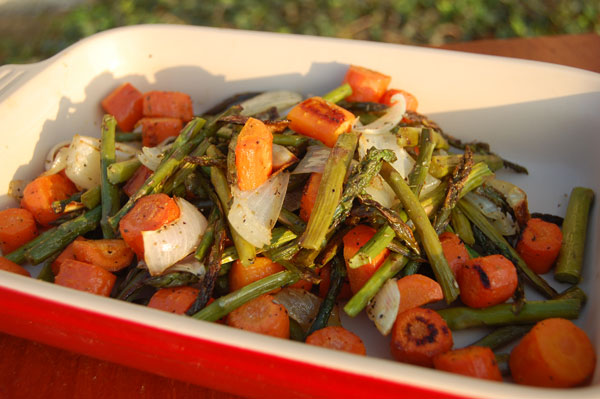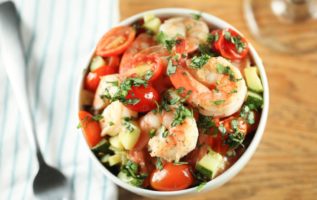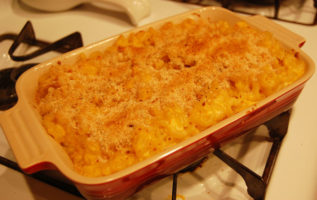
When it comes to roasting, meaty dishes usually steal the show. Almost all of us have enjoyed a hot-out-of-the-oven Thanksgiving turkey, juicy prime rib or flavorful and flaky salmon fillet.
But roasting needn’t be relegated to meat, poultry and fish. The same properties of roasting that impart so much flavor to those protein-rich dishes work wonders for vegetables, too.
The easiest way to roast is in an oven, which uses hot air as the main vehicle to cook food. (You could also call this “baking,” though that term is often used in reference to breads, pastries and meat without bones. For our purpose here, either word is safe, but “roasting” sounds more appetizing, no?) Roasting yields vegetables that are firm yet not hard, browned and visually interesting, and that taste so much more potent than when steamed or simmered.
When you roast, you actually concentrate flavors inward, vs. leeching them out. For example, when you simmer meat or vegetables in water, many of the flavors and nutrients go into that water. That’s great if you’re making broth or stock, but it’s wasted if you don’t use the liquid.
Roasting solves this problem. While the water in foods still goes out – you might notice the foods shrink a bit – that makes their flavors more intense as they become browned.
To roast a vegetable, all you need is an oven and a sheet pan or other shallow, oven-safe dish. You can even use a toaster oven if you’re making small quantities. To really roast right, the best method is to cut the vegetables in small pieces roughly the same size, toss them lightly in olive oil, then sprinkle with salt, pepper and herbs before spreading on a foil-lined tray and sending them to roasting heaven.
Cutting the pieces to roughly the same size will help them cook evenly and in the same amount of time, while the olive oil (seen being poured on below) and salt, pepper and herbs will add protection from the heat and impart extra flavor.
What veggies can you roast? The question is more like, Which can’t you roast? If there is one you particularly like, you’ll probably love it roasted. Asparagus, potatoes, squash and carrots are popular choices, but your options extend far beyond that.
Denser vegetables will require more time, so if you’re mixing and matching, you might want to give them a head start and add softer veggies later. There really is no set time for when they’re done, as it depends on variables like which vegetable is used and your particular oven.
I usually cook veggies at 425 degrees and watch for them to turn brown before tasting. The process usually takes only 20 to 30 minutes.
If you’re new to roasting veggies, start right here. We’ll do a mix of carrots, onions and asparagus. This makes an excellent side dish or, for vegetarians, can be a main course when topped with a crumbled cheese and served with soup or bread. Alternately, it can be served slightly chilled as a salad, dressed in a vinaigrette.
ROASTED VEGGIE TRIO
(Makes 2 to 4 servings)
- 1 bunch (about 1 pound) asparagus, rinsed well
- 4-5 carrots, peeled
- 1/2 medium brown onion
- 2-3 tablespoons olive oil
- 1 teaspoon salt or garlic salt
- 1/2 teaspoon ground black pepper
- 1 teaspoon your choice dried herbs
- Fresh lemon juice for drizzling (optional)
Step 1: Preheat the oven to 425 degrees. While the oven is heating, cut the veggies into small pieces, about bite-size. For the asparagus, trim off the tough, woody end that is opposite of the pointy one.
Step 2: Put all the vegetables in a large bowl. Pour in the olive oil and toss well to coat (this will help the salt, pepper and herbs adhere). Sprinkle in the salt, pepper and herbs, and toss again to coat. I prefer herbes de Provence, which include dried thyme, basil and marjoram. Oregano, basil or rosemary could also work well.
Step 3: Spread the vegetables evenly on a large baking pan that has been lined with foil, which will make cleanup easier. Try to spread everything in one layer so the veggies aren’t crowded.
Step 4: Pop the pan into the oven and cook for 20 minutes or until veggies start to brown. Open oven and, using a long spatula, stir carefully. Roast for an additional 10 to 15 minutes or until the vegetables are to your liking.
Step 5: Carefully remove the pan from the oven and serve the veggies warm, adding a splash of lemon juice for extra flavor and tang if desired. Refrigerate any leftovers and enjoy the next day. These will reheat easily in the microwave and can easily be mixed in with other recipes.
Congratulations: You’ve just roasted vegetables. Now that you know the process, experiment! You can now easily transform garlic, potatoes, tomatoes, peppers and squash into something extraordinary using this same procedure.
Source: iwanttocook.com (defunct blog)


































